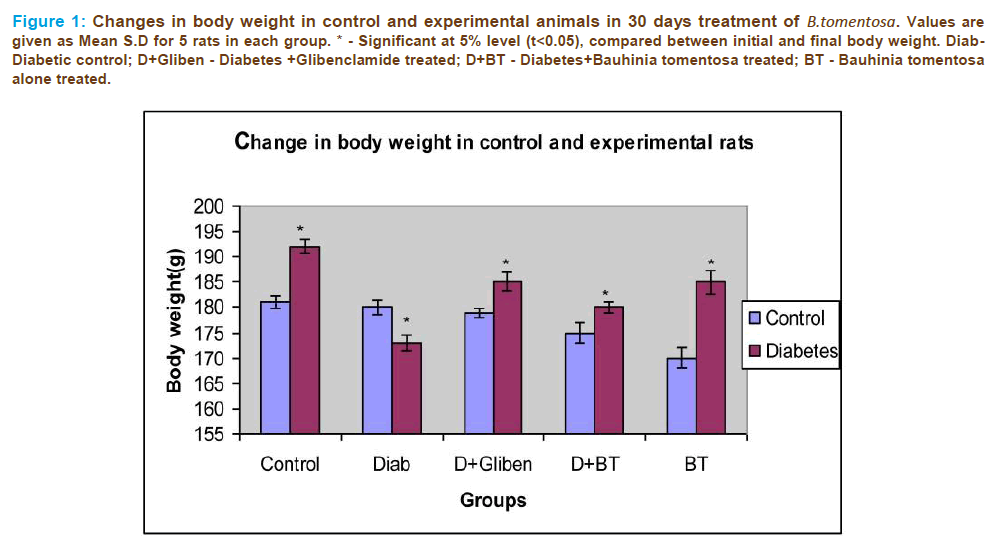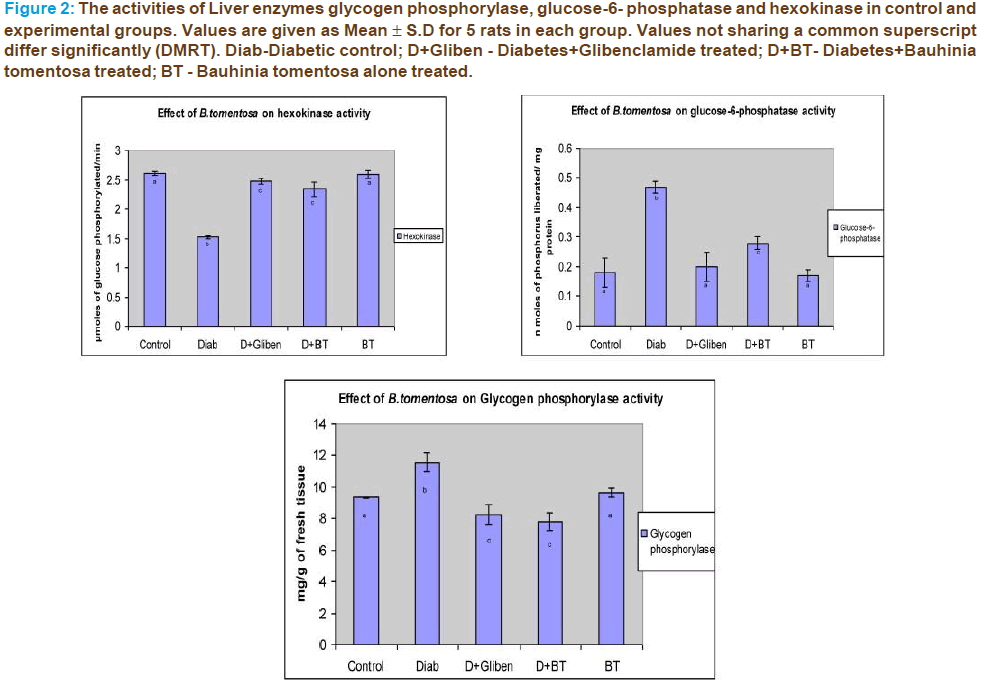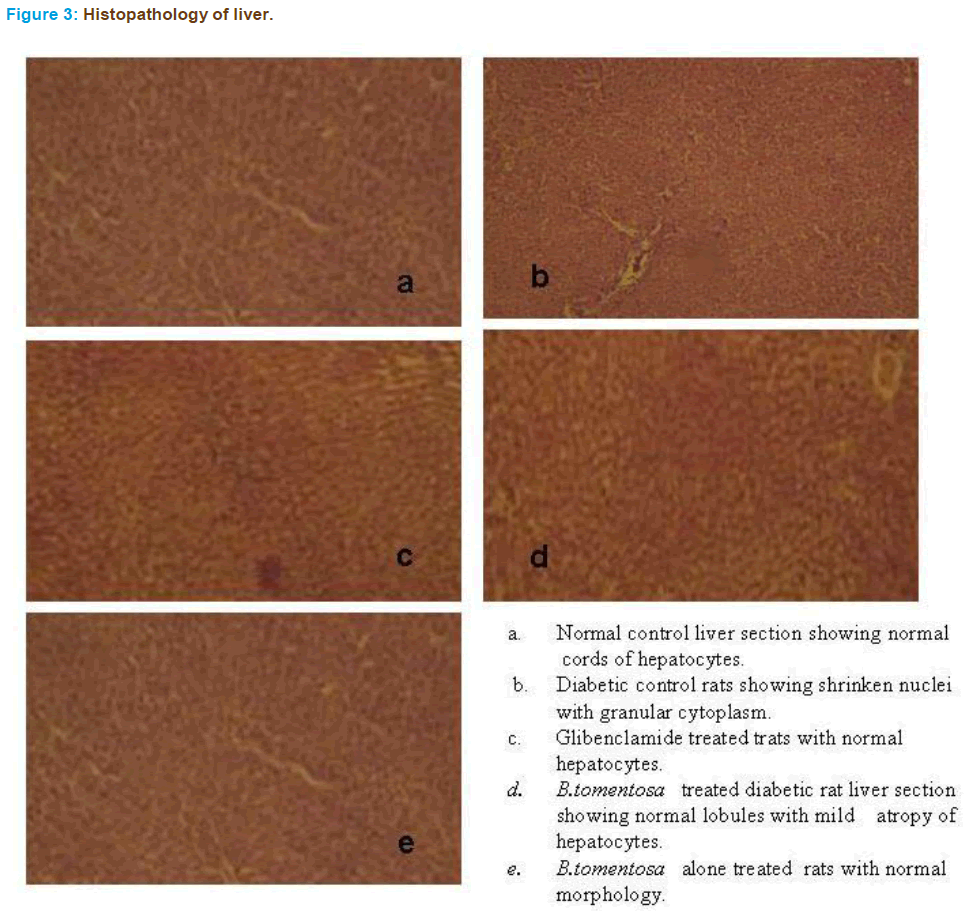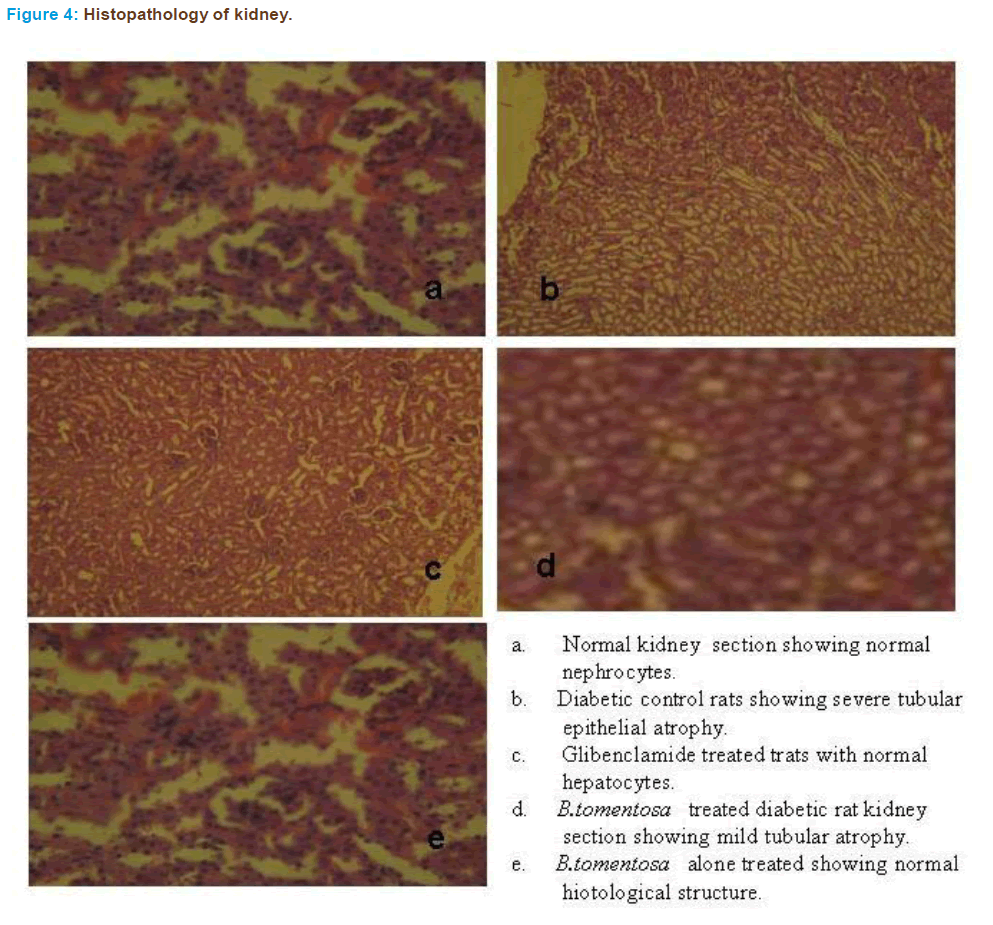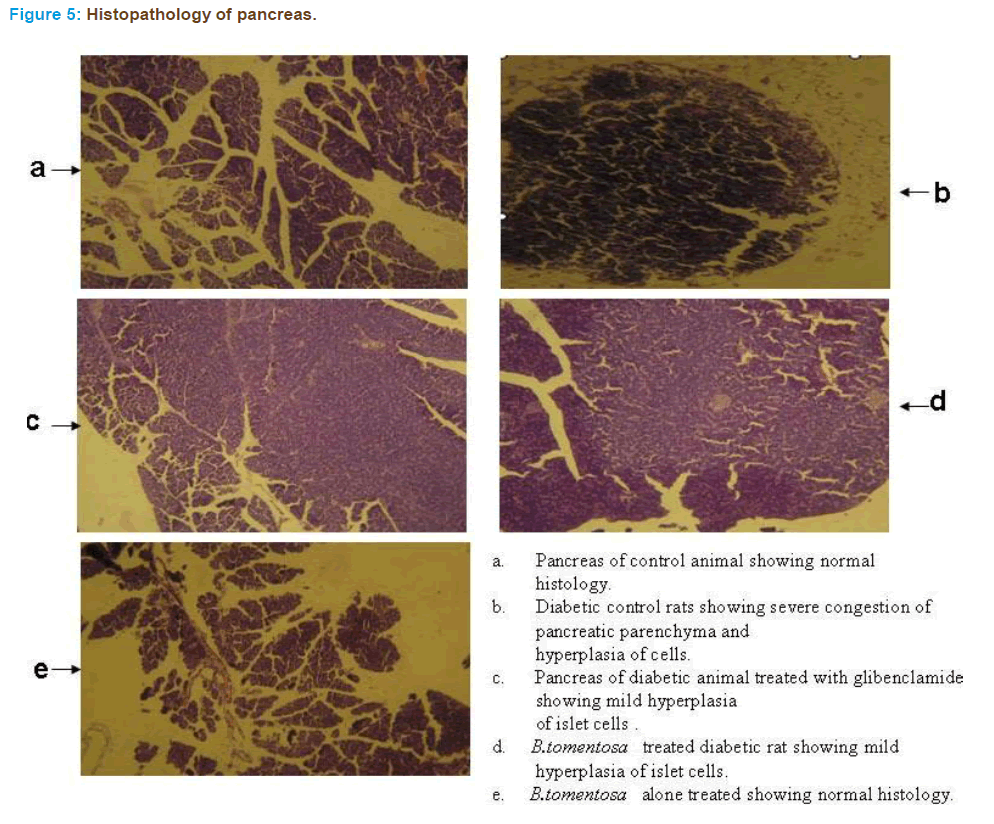Glucose lowering effect of aqueous extract of Bauhinia tomentosa L. on alloxan induced type 2 diabetes mellitus in wistar albino rats
- *Corresponding Author:
- V. K.Gopalakrishnan
Department of Biochemistry, Karpagam University, Coimbatore-641 021 (T.N.), India.
E-mail: vkgopalakrishnan@gmail.com
Date of Received : 19-04-2011
Date of Accepted : 22-06-2011
Available Online : 15-11-2011
Abstract
The study was designed to evaluate the anti-diabetic effect of aqueous extract of Bauhinia tomentosa L. leaf on alloxan induced Wistar albino rats. Diabetes was induced in albino rat models with alloxan monohydrate (150mg/kg body weight). Aqueous leaf extract of Bauhinia tomentosa at the dose of 300 mg/kg was orally administered once a day for 30 days to the diabetic animals. In this study, glycemic parameters, lipid parameters and serum enzymes were reduced whereas the level of high-density lipoprotein-cholesterol was elevated. The extract significantly increased the total protein and glycogen level in the liver of diabetic rats. Furthermore, the liver carbohydrate metabolizing enzymes were normalized by the administration of the extracts. Histopatholgical examination results of liver, pancreas and kidney were normal in general. The above results indicated the anti-diabetic efficacy of the B.tomentosa leaf extract.
Keywords
B.tomentosa, antidiabetic, hypoglycemia, hepatic enzyme, alloxan mono hydrate
Introduction
Diabetes mellitus is a common metabolic and endocrine disorder, charac- terized by chronic hyperglycemia and disturbance of carbohydrate, fat and protein metabolism associated with absolute or relative deficient of insulin secretion or insulin action [1]. It is a metabolic disorder principally characterized by chronic and persistent hyperglycemia [2]. It is well known that the incidence of diabetes mellitus is high all over the world, especially in Asia. Ac- cording to the World Health Organization (WHO) projections in 2005, the 30 million to 33 million diabetes in India will go up to 40 million by 2010 and 74 million by 2025. WHO has issued a warning that India will be the diabetic capital of the world [3].
Different types of oral hypoglycemic agents such as biguanides and sulphonyl urea are available along with insulin for the treatment of diabetes mellitus (4). But side effects were associated with their uses [5,6]. There is a growing interest in herbal remedies because of their effectiveness, minimal side effects in clinical expe- rience and relatively low costs. Herbal drugs or their extracts are prescribed widely, even when their biological active compounds are unknown. Even WHO approves the use of plant drugs for different diseases, including diabetes mellitus. Ethno botanical information indicates that more than 800 plants are used as traditional remedies for the treatment of diabetes [7].
Bauhinia tomentosa L. is a well known, traditional plant used in folklore medi- cine in tropical regions around the world and especially in greater parts of India. There are about 600 species of Bauhinia L. in the tropical regions [8]. Bauhinia tomentosa is a fast-growing plant that grows up to 4m in height. Leaves are divided into two lobes, light green in colour, with a leathery texture. Infusion of fresh flowers and barks were used for dysentry. Decoction of root bark was used for liver problems and leaves were externally applied to the forehead for fevers. Large number of Bauhinia species were analysed for their antidiabetic effect but the antidiabetic effect of B.tomentosa is scarse. So this study aimed in finding the antidiabetic potential of B.tomentosa.
Materials and Methods
Plant material and extraction
Bauhinia tomentosa leaves were collected from a local farm and authenticated by Dr.G.V.S.Moorthy, Botanical Survey of India, Tamilnadu Agricultural Univer- sity Campus, Coimbatore. The Voucher No is BSI/SRC/73/5/23/09-10/Tech.- 723 and the specimen was deposited in the department herbarium. After washing with water the leaves were dried at 250C for 10 days in the absence of sunlight and powdered well using a mixer. Then they were weighed and kept in an airtight container and stored in refrigerator until future use.
Animals
Healthy adult albino rats of both sex, weighing approximately 150-180g were procured from animal house of Karpagam University, Coimbatore and used for the study. Rats were housed at constant temperature of 22+5°C with a 12-hour light, 12-hour dark cycle. Before and during the experiment, rats were fed with standard diet. All the experiments were carried out according to the guidelines recommended by the Committee for the Purpose of Control and Supervision of Experiments on Animals (CPCSEA), Government of India.
Induction of diabetes
Diabetes induction was done by single intra peritoneal injection of alloxan mono- hydrate (150 mg/kg) in saline. The hyperglycemia was confirmed after 72 hrs by the elevation of blood glucose and the behavioral changes (Excess thirst and frequent urination).The rats with blood glucose level more than 250 mg/dl were considered as diabetics and used for the study.
Experimental design
A total of 25 rats (15 diabetic surviving rats, 10 normal rats) were used. Rats were divided into five groups containing five animals in each group. Group I served as untreated control. Group II was diabetic control. Group III and Group IV were diabetic rats received orally administration of standard drug glibenclamide (5mg/ kg) and aqueous leaf extract of B.tomentosa (300mg/kg) respectively. Group V was normal rats treated with B.tomentosa (300mg/kg) alone. The treatment groups were given the extract through the oral gastric tube for a period of 30 days.
Blood Collection
After the study period, the animals were kept overnight fast and sacrificed under light chloroform anesthesia. Blood was drawn from the ventricles and centrifuged. Serum was separated and analyzed for various biochemical estimations. Liver, pancreas and kidney were excised immediately, washed with ice cold saline stored in 10% formalin and 0.9% saline, for histopathological and biochemical studies respectively.
Biochemical Estimations
Commercial diagnostic kits were used to estimate blood glucose level colorimet- rically. (Sigma Diagnostics Pvt Ltd, Baroda, India). Lowry et al (1951) method was used for estimation of protein in serum and liver [10]. Serum lipid profile, serum glutamate oxaloacetate transaminase (SGOT), serum glutamate pyruvate transaminase (SGPT),alkaline phosphatase (ALP), serumurea , creatinine , protein and albumin content were determined by standard procedures in an auto analyzer using Ecoline kits(E.Merck,Mumbai,India). Liver glycogen was estimated [11] and carbohydrate metabolic enzymes of liver like glycogen phosphorylase [12], Glucose-6-phosphatase [13] and Hexokinase [14] were also analysed. From the lipid profile, atherogenic index (AI) and coronary risk index (CRI) were cal- culated.


Statistical analysis
All the values were expressed as Mean + SD of five individual experiment and the statistical significance was evaluated by one way analysis of variance (ANOVA) using SPSS version (10.0) and the individual comparisons were obtained by the Duncan multiple range test (DMRT) [15]. A value of p<0.05 was considered to indicate a significant difference between the groups.
Results and Discussion
Changes in body weight
As shown in Figure 1, control rats were found to be stable in their body weight whereas in diabetic rats there was a significant decrease in the body weight. The reduction of body weight in diabetes may be attributed due to insulin insufficiency. This results in starvation of cell for glucose which leads to the utilization of structural proteins [16,17]. Diabetic treated rats brought about improvement in body weights in group III and IV, indicating the beneficial effect of glibenclamide and B.tomentosa respectively in preventing loss of body weight in diabetic rats due to its ability to prevent the destruction of structural proteins.
Figure 1: Changes in body weight in control and experimental animals in 30 days treatment of B.tomentosa. Values are given as Mean S.D for 5 rats in each group. * - Significant at 5% level (t<0.05), compared between initial and final body weight. Diab-Diabetic control; D+Gliben - Diabetes +Glibenclamide treated; D+BT - Diabetes+Bauhinia tomentosa treated; BT - Bauhinia tomentosa alone treated.
Change in glucose, insulin, hemoglobin and glycosylated hemoglobin (HbA1C)
Table 1 shows significant increase in glucose, glycosylated hemoglobin and sig- nificantly reduction in insulin and hemoglobin (p<0.05) in alloxan treated diabetic rats. The standard antidiabetic drug glibenclamide and aqueous extract of P.edulis (200mg/kg) significantly reduced (p<0.05) the blood glucose level in diabetic rats, but not to the level of control rats. Alloxan induce diabetes mellitus with a single dose administration which cause selective necrosis of pancreatic β-cells of islets of langerhans that initiate insulin deficiency which end up with increase in the blood sugar level. In vitro studies proved that alloxan mediate cytotoxic action by producing ROS that caused destruction of β-cells [18]. Glibenclamide, the oral hypogly- cemic agent is known to mediate its hypoglycemic effect by stimulating insulin release from the pancreatic β-cells. It also stimulates the release of somatostatin and suppresses the secretion of glucagons [19].
| Parameters | Control (Group I) | Diabetic control (Group II) | Diabetic+ Glibenclamide treated (Group III) | Diabetic+ B.tomentosa treated (Group IV) |
B.tomentosa Treated (Group V) |
|---|---|---|---|---|---|
| Glucose (mg/dl) | 106.00 ± 1.82a | 240.25 ± 1.01b | 104.25 ± 0.82a | 113.00 ± 1.78c | 108.33 ± 1.86d |
| Insulin (mU/L) | 0.42 ± 0.14a | 0.25 ± 0.16b | 0.49 ± 0.57c | 0.40 ± 0.01a | 0.41 ± 0.01a |
| Hemoglobin (g/dl) | 16.2 ± 1.18a | 14.23 ± 0.13b | 15.73 ± 0.14c | 15.1 ± 0.27d | 15.4 ± 0.31e |
| Glycosylated Hemoglobin (%) |
9.16 ± 0.02a | 15.7 ± 0.09b | 9.07 ± 0.05a | 10.4 ± 0.09d | 9.12 ± 0.02a |
Values are given as Mean ± S.D for five individual experiments
Values not sharing a common superscript differ significantly (DMRT)
Table 1: Effect of B.tomentosa leaf extract on the concentration of glucose, insulin, hemoglobin and glycosylated hemoglobin of control and experimental groups.
Excess glucose present in the blood reacts with hemoglobin to form HbA1C, so the level of hemoglobin decreased and the glycosylated hemoglobin level increased in alloxan induced diabetic rats. HbA1C is an important parameter of chronicglycemic control in patients with diabetes mellitus and an elevated HbA1C always indicates the uncontrolled diabetes mellitus [20,21]. Treatment of diabetic rats with B.tomentosa significantly reduced the above parameters and this is due to the improved glycemic control exerted by the B.tomentosa extract. The serum hemoglobin concentration is an important predictor of both macrovascular and microvascular complications of diabetes mellitus that might cause coronary mortality and lower extremity amputations [22]. Since the aqueous extract of B.tomentosa effectively prevents the HbA1C elevations, it prevents complications such as macrovascular and microvascular complications including coronary mortality. .B.tomentosa alone treated rats did not show any significant difference with control rats. Numerous studies have demonstrated that a variety of plant contain the secondary metabolites like glycosides alkaloids, terpenoids, flavonoids and tannin, etc. They have been proved to be antidiabetic by different mechanism of action [23].
Change in renal and hepatic markers
Concentration of renal markers urea, uric acid and creatinine and the liver marker enzymes SGOT, SGPT and ALP were found to be increased in diabetic rats (Table 2). In diabetic nephropathy, there will be a renal vein thrombosis and fibrin degradation that causes significant decrease in glomerular filtration rate (GFR), and increase in blood urea and creatinine. The changes in serum enzyme level in diabetic animals are directly related to changes in the metabolism in which the enzymes are involved; hence the SGOT and SGPT activities have been used as a sen- sitive indicator of liver function [24,25]. The urea, uric acid, creatinine level and the liver marker enzymes levels of the diabetic rats administered with B.tomentosa reduced to almost normal level. The reversal of renal and hepatic markers to their normalcy is the evidence of the prevention of cellular and tissue damage under diabetic conditions and the revival of insulin secretion to normal levels. The Group V control rats showed no significant change in all the above parameters indicate the safety nature of the extract on these vital organs.
| Parameters | Control (Group I) | Diabetic control (Group II) | Diabetic+ Glibenclamide treated (Group III) | Diabetic+ B.tomentosa treated (Group IV) |
B.tomentosa Treated (Group V) |
|---|---|---|---|---|---|
| Urea (mg/dl) | 35.22 ± 0.52a | 43.50 ± 4.43b | 31.58 ± 0.55c | 33.47 ± 0.22e | 35.5 ± 2.08ad |
| Uric acid (mg/dl) | 1.92 ± 0.12a | 3.52 ± 0.10b | 2.47 ± 0.09c | 2.29 ± 0.15d | 1.91 ± 0.06a |
| Creatinine (mg/dl) | 0.82 ± 0.02a | 1.04 ± 0.07b | 0.74 ± 0.13c | 0.69 ± 0.15d | 0.81 ± 0.0a |
| SGOT (U/L) | 27.25 ± 0.95a | 50.75 ± 2.21b | 37.75 ± 1.71c | 30.50 ± 2.64d | 26.00 ± 1.41a |
| SGPT (U/L) | 44.5 ± 1.29a | 53.00 ± 3.16b | 39.12 ± 0.85c | 37.50 ± 1.09c | 42.25 ± 0.95a |
| ALP (U/L) | 96.16+2.62a | 250.51 + 6.31b | 130.17 + 2.81c | 140.82 + 2.89d | 100.31 + 1.86a |
Values are given as Mean ± S.D for five individual experiments
Values not sharing a common superscript differ significantly (DMRT)
Table 2: Effect of B.tomentosa leaf extract on the concentration of urea, uricacid, creatinine, SGOT, SGPT and ALP in serum of control and experimental groups.
Change in lipid profile
Hyperlipidemia that characterizes the diabetic state may therefore be regarded as a consequence of the uninhibited actions of lipolytic hormones on the fat depots [26]. Table 3 shows significant elevation of TC, TG, LDL, and VLDL along with a decrease in HDL cholesterol in diabetic rats and its reversal by the administra- tion of aqueous extract of B.tomentosa. In diabetic treated rats, significant increase in HDL and decrease in the level of TC, TG, LDL, VLDL was noticed. The li- pid profile demonstrated no significant change in Group V when compared with control rats. The results of this study revealed that a continuous administration of aqueous leaf extract of B.tomentosa for 30 days prevented the elevation of the level of serum lipids, secondary to the diabetic state. The hypolipidemic effect of B.tomentosa can be explained as a direct result of the reduction in the blood glucose concentration which reduced the formation of triacyl glycerol. The observed result may be primarily because of the hypolipidemic effect of the extract by normalizing the insulin level in the serum of treated animals. Literatures also reported that the flavonoids, alkaloids and tannins are responsible for hypoglycemic and hypolipidemic effect [27]. The atherogenic and cardiac risk index of diabetic rats treated with B.tomentosa significantly reduced. This supported that B.tomentosa will prevent cardiovascular complications secondary to diabetes.
| Parameters | Control (Group I) | Diabetic control (Group II) | Diabetic+ Glibenclamide treated (Group III) | Diabetic+ B.tomentosa treated (Group IV) |
B.tomentosa Treated (Group V) |
|---|---|---|---|---|---|
| Cholesterol (mg/dl) |
121.03 ± 1.47a | 266.33 ± 1.36b | 117.73 ± 1.72c | 115.2 ± 1.17c | 118.0 ± 1.79ac |
| Triglycerides (mg/dl) |
80.67 ± 1.05a | 218.8 ± 1.17 b | 87.47 ± 1.22 c | 90.93 ± 1.5d | 79.73 ± 1.14a |
| HDL (mg/dl) |
42.07 ± 1.35a | 29.73 ± 1.02b | 40.13 ± 1.61ac | 39.73 ± 1.70c | 41.73 ± 1.54a |
| LDL (mg/dl) |
58.73 ± 1.50a | 191.33 ± 2.07b | 58.53 ± 1.27a | 56.00 ± 0.99a | 57.73 ± 1.26a |
| VLDL (mg/dl) |
20.5 ± 1.16a | 45.53 ± 1.52b | 18.8 ± 1.25ac | 17.27 ± 1.15c | 18.53 ± 1.74ac |
| AI | 10.95 ± 0.08 | 2.25 ± 0.05 | 3.85 ± 0.06 | 1.45 ± 0.03 | 1.75 ± 0.02 |
| CRI | 2.02 ± 0.03 | 12.01 ± 0.04 | 3.70 ± 0.02 | 2.98 ± 0.02 | 1.15 ± 0.04 |
Values are given as Mean ± S.D for five individual experiments
Values not sharing a common superscript differ significantly (DMRT)
Table 3: Effect of B.tomentosa leaf extract on the concentration of cholesterol, triglycerides, HDL, LDL and VLDL in serum of control and experimental groups.
Change in total protein, albumin and globulin
A sharp fall in total protein and a slight decline in albumin, globulin and a signifi- cant change in A/G ratio were observed in diabetic rats [28]. In table 4, the total protein and albumin were decreased in diabetic rats but increased with B.tomentosa treatment in Group III and Group IV. No significant change was found between control and treatment groups in globulin and A/G ratio. In treated groups, B.tomentosa improve the insulin secretion and reverse the altered protein profile by exerting the protein sparing effect. Significant increase in urinary excretion of protein, albumin, glucose and urea levels indicated the impaired renal function in diabetes, and the treatment of herbal remedies prevented such diabetic nephropathic complications was already established [29].
| Parameters | Control (Group I) | Diabetic control (Group II) | Diabetic + Glibenclamide treated (Group III) | Diabetic + B.tomentosa treated (Group IV) |
B.tomentosa treated (Group V) |
|---|---|---|---|---|---|
| Total protein (g/dl) | 8.08 ± 0.07a | 4.47 ± 0.03b | 8.03 ± 0.01a | 7.77 ± 0.06c | 8.06 ± 0.03a |
| Albumin (g/dl) | 5.07 ± 0.02a | 2.30 ± 0.09b | 4.75 ± 0.03c | 4.55 ± 0.03d | 5.01 ± 0.03a |
| Globulin (g/dl) | 3.17 ± 0.14ac | 2.11 ± 0.08b | 3.28 ± 0.09cd | 3.35 ± 0.06d | 3.06 ± 0.11a |
| A/G Ratio | 1.59 ± 0.03a | 1.09 ± 0.07b | 1.45 ± 0.03c | 1.41 ± 0.05c | 1.66 ± 0.04a |
Values are given as Mean ± S.D for five individual experiments
Values not sharing a common superscript differ significantly (DMRT)
Table 4: : Effect of B.tomentosa leaf extract on the concentration of total protein, albumin, globulin and A/G ratio in serum of control and experimental groups.
Changes in liver glycogen and protein
Liver plays a role in buffering the post prandial hyperglycemia and is involved in the synthesis of glycogen. Insulin deficiency in diabetes mellitus is known to impair the normal capacity of the liver to synthesis glycogen. The decrease in glycogen synthase and simultaneous increase in glycogen phosphorylase results in an increased glycogenolysis hence increases the blood glucose. This further worsens the diabetic condition.
In Table 5 significant decrease in liver glycogen and protein level was ob- served in diabetic rats. The observed depletion of glycogen level in diabetic rats was consistent with the earlier reports [30], indicating that it was possibly due to loss of glycogen synthetase activating system or increased activity of glycogen phosphorylase. It was pertinent to believe that the liver glycogen level of alloxan treated animals would decrease, as the synthesis of glycogen depended on insulin for the influx of glucose. Furthermore, earlier studies also showed that the reduced hepatic glycogen content was normalized by insulin treatment [31]. In diabetic treated groups, increase in glycogen was the direct effect of B.tomentosa on insulin secretion [32].
| Parameters | Control (Group I) | Diabetic control (Group II) | Diabetic + Glibenclamide treated (Group III) | Diabetic + B.tomentosa treated (Group IV) |
B.tomentosa treated (Group V) |
|---|---|---|---|---|---|
| Glycogen (mg/g of fresh tissue) | 4.33 ± 0.15a | 1.3 ± 0.03b | 3.24 ± 0.01c | 3.11 ± 0.24c | 4.14 ± 0.14a |
| Protein (mg/g of fresh tissue) | 13.70 ± 0.75ac | 9.66 ± 0.57b | 13.16 ± 0.36ac | 12.90 ± 0.68c | 14.20 ± 0.61a |
Table 5: Effect of B.tomentosa leaf extract on the concentration of total protein, albumin, globulin and A/G ratio in serum of control and experimental groups.
In B.tomentosa and glibenclamide treated rats, there was an improvement in protein profile. It may be due to marked change in circulating amino acid levels, hepatic amino acid uptake, and muscle output of amino acid concentrations [33]. It was found that the administration of B.tomentosa improved the protein profile in diabetic rats. This indicated that the plant extract have the potency of reversing the altered protein profile similar to that of the drug glibenclamide.
Changes in hepatic enzymes
Significant increase in glycogen phosphorylase, glucose-6-phosphatase and lowered level of glucokinase were observed in diabetic rats (Figure 2). Glucokinase is present in the cells of liver that catalyze the conversion of glucose to glucose-6-phosphate and plays a central role in the maintenance of glucose homeostasis [34]. Glucose-6-phosphatase is one of the key enzymes in the homeostatic regulation of blood glucose level whose action is controlled by insulin. In the absence of insulin, increased glycogen phosphorylase activity was observed that lead to decrease in glycogenesis or increase in glycogenolysis in liver [35]. The altered activities of the enzymes were reversed by the administration of B.tomentosa and glibenclamide. The observed result may be due to the direct effect of B.tomentosa on insulin secre- tion. Insulin, increases hepatic glycolysis by increasing the activity and amount of several key enzymes including glucokinase and inhibiting the enzymes like lucose- 6-phosphatase and glycogen phosphorylase.
Histopathology
Figure 3-5 illustrate the effect of B.tomentosa leaf extract on the liver, kidney and pancreas of control and experimental rats. The degenerative changes associated with alloxan administration were reversed by the extract in all the three organs taken for the study.
The result of the study demonstrated that the aqueous leaf extract of B.tomentosa (300mg/kg) by oral adminstration to diabetic rats contain novel bioactive principles with antihyperglycaemic properties. Although promising results have been obtained, more efforts are still needed for the isolation, characterization and biological evaluation of the active principle(s) of the extracts.
Acknowledgements
The authors express their sincere gratitude to the Chairman and Chancellor, Advi- sor, Vice Chancellor and Registrar of Karpagam University, Coimbatore, India for providing facilities to carry out the study.
References
- De’Souza A, Shahani SR, Ainapure SS. Evaluation of Hypoglycamic effect of Pterocarpus marsupium comparison with Glibenclamide in alloxan induced Diabetic rabbits. Indian Drugs. 2005; 43: 452-456.
- Gupta M, Suresh C, Shinde GB. Pro-oxidant and anti – oxidant status in non- insulin dependent diabetes mellitus. The Antiseptic. 2006; 579-5813.
- Ramachandran A, Snehalatha C, Vijay V, Wareham NJ, Colagiuri, S. Deriva- tion and validation of diabetes risk score for urban Asian Indians. Diab Res Clin Pract. 2005; 70: 63-70.
- Holman RR, Turner RC. Oral Agents and insulin in the treatment of Diabetes. Blackwell Oxford. 1991; 467-469.
- Rao K, Giri R, Kesavulu MM, Apparao C. Herbal medicine. In the 1manage- ment of diabetes mellitus. Manphar Vaidhya Patrica. 1997; 1: 33 – 35.
- Valiathan MS. Healing plants. Current Science. 1998; 75: 1122- 1126.
- Pushparay P, Tan CH, Tan BKH. Effect of Averrhoea bilimbi leaf extract on blood glucose and lipid in STZ- diabetic rats. J. Ethanopharmacol. 2000; 72:69-76.
- Larson SS. Pollen Morphology of Thai species of Bauhinia (Caesalpiniaceae). Grana.1974; 14:114-31.
- Lott JA, Turner K. Evaluation of Trinder’s glucose oxidase method for measur- ing glucose in serum and urine. Clin.chem. 1975; 12: 1754-1760.
- Lowry OH, Rosebrough NJ, Farr AL, Randall RJ. Protein measurement with Folins phenol reagent. J Biol Chem. 1951; 193: 265.
- 11. Morales MA, Jabbagy AJ and Terenizi HR. Mutation affecting accumula- tion of glycogen. Neurospora News Letter. 1973; 30: 24-25.
- Cornblath M, Randle PJ, Parmeggiani A and Morgan HE. Regulation of glycogenolysis in muscle. Journal of Biol Chem. 1963; 238: 1592–1597.
- King J. The dehydrogenases or oxidoreductases. Lactate dehydrogenase London: Van Nostrand, D.Company Ltd. In: Practical Clinical Enzymology. 1965; 309-341.
- Brandstrup N, Kirk JE, Bruni C. Determination of hexokinase in tissues. J. Gerontol, 1957; 12: 166-171.
- Duncan BD. Multiple ranges tests for correlated and heteroscedastic means. Biometrics. 1957; 130: 359-364.
- Eshrat Halim M. Lowering blood sugar by water extracts of Azadirachta indi- ca and Abroma Augusta bin diabetes rats. Ind J Exp Biol. 2003; 41: 636-640.
- Pries E, Garrity L, Kays N and Daniel M. Growth hormone treatment of a child with growth hormone deficiency, type 1 diabetes and chronic steroid use. J Pediatric Nursing. 2006; 21: 1-6.
- Bhagvat DA, Killedar SG and Adnaik RS. Antidiabetic activity of leaf extract of Tridax procumbens. International Journal of Green Pharmacy. 2008; 2: 126-129.
- Adeneye AA and Olagunju JA. Preliminary hypoglycemic and hypolipidemic activities of the aqueous seed extract of Carica papaya Linn. in wistar albino rats. Biology and Medicine. 2009; 1: 1-10.
- Jerald EE, Joshi SB and Jain DC. Antidiabetic activity of aqueous extract and non polysaccharide fraction of Cynodon dactylon Pers. Ind J Exp Biol. 2008; 46: 660-667.
- Shirpoor A, Khadem AMH, Salami S, Ghaderi PF and Rasmi Y. Effect if Vit E in oxidative stress in GI tract of diabetic rats. World J Gastroenterol. 2007; 13: 4340-4344.
- Marica JB, Veijko B, Jadranka B, Zeiljko M, Ivan J and Zeljko R. Impact of glycemiccontrol on antioxidant enzyme activity in patients with type 2 diabe- tes mellitus. Diabetologia croatica. 2004; 4: 33-34.
- Patel S, Rajendra SS and Ramesh KG. Antihyperglycemic, antihyperlipidemic and antioxidant effects of Dihar, a poly herbal formulation in Streptozotocin induced diabetic rats. Ind J Exp Biol. 2009; 47: 564-570.
- Ghosh S and Suryawanshi SA. Effect of Vinca rosea extracts in treatment of alloxan diabetes in male albino rats. Ind J Exp Biol. 2001; 39: 748-759.
- Perfumi M, Arnold N and Tacioni R. Hypoglycemic activity of Salvia fruticosa Mill from Cyprus. Journal of Ethnopharmacology. 1991; 34:135-140.
- Goodman LS and Gilman A. The pharmacological basis of therapeutics. Mac millan, New york, 1985; 7: 1490-1510.
- Adeneye AA and Olagunju JA. Preliminary hypoglycemic and hypolipidemic activities of the aqueous seed extract of Carica papaya Linn. in wistar albino rats. Biology and Medicine. 2009; 1:1-10.
- Sumana G, Suryawanshi SA. Effect of Vinca rossa extracts in treatment of alloxan diabetes in male albind rats. Indian Journal of Experimental Biology. 2001; 39: 748 – 759.
- Tedong L, Dimo T, Dzeufiet PD, Asongalem E, Sokeng DS, Callard P Flejou F and Kamtchouing P. Antihyperglycemic and renal protective activities of Anacardium occidentale leaves in streptozotocin induced diabetic rats. Afr J Trad CAM. 2006; 3: 23-35.
- Abdel-Moniem A, El-Feki M and Salh E. Effect of Nigella sativa, fish oil and gliclazide on alloxan diabetic rats-Biochemical and Histopathological studies. J Egypt Ge. 1997; 23: 237-265.
- El-Shenaway NS and Abdel-Nabi Im Hypoglycemic effect of Clome droserifo- lia leaf extract in experimental diabetes and on non – enzymatic antioxidant, glycogen, and thyroid hormone and insulin levels. Diabetolgia Croatica. 2006; 35: 15.
- Felig P, Wahren J, Herwin RS, Alaiogos G. Protein and aneino acid metabo- lisms in diabetes mellitus. Arch Inte Med. 1977; 3: 507.
- Mallikarjuna Rao C, Parameshwar S and Srinivasan KK. Oral antidiabetic activities of different extracts of Caesalpinia bonducella seed kernels. Phar- maceutical Biology. 2002; 40: 590-595.
- Vasanthakumari V, ShyamalaDevi CS. Evaluation of antidiabetic effect of an ayurvedic drug “Taeakeswara rasa” in rats. Indian Journal of Experimental biology. 1997; 35: 909-911.
- Babu V, Gangadevi T, Subramoniam A. Antidiabetic activity of ethanol ex- tracts of Cassia klenii leaf in streptozotocin – induced diabetic rats. Ind J Pharmacol. 2003; 35: 290-296.


